One of my favourite autumn/winter memories is flying to Budapest for work. I was working for a Hungarian Oil and Gas company in Italy and for work related training and professional conferences, I flew to Budapest quite often. However short-lived, those were the happiest times of my work life when I felt that my work was very fulfilling because it not only gave me a sense of self-worth but also fulfilled my passion to travel.
Budapest is the capital city of Hungary and one of the most magnificent European capitals in every sense, be it the historical, cultural, political and architectural prowess that it exerts or simply its role in the world’s tourism scenario owning a coveted UNESCO World Heritage Site.
It comprises of Buda and Pest situated at the western and eastern side of the Danube River respectively, that connects them through a series of bridges and forms one grand city Budapest. When the city was first formed in 1873, it also merged the old town of Óbuda. Today all three of them make one city which is divided into different districts. Each of the towns is wonderful in itself to be explored and marveled at. The city portrays a lot of character, grandeur and majesty of the empires that ruled and left their imprints on its social, cultural and historical scene. From Romans to Ottomans to German occupation, the city went through so much transformation and still stands with the same magnificence that great cities of this calibre have demonstrated to the world. This important city in the Hungarian Kingdom saw its most prosperity and growth reaching new heights of grandeur and class in the Ottoman era from 1541 to 1699.
The history lesson is over, I promise and let us get on with my experience of exploring Budapest and relishing in the many joys the city has to offer. It was almost an hour and a few mins flight from Milan airport to Budapest making it a quick trip for me, like many other European cities. The Budapest Ferenc International airport is almost 20 kilometers from the city and can be reached in an average of 30 minutes depending on the mode of transport and time of the day of course. Taxis are quite affordable and cost around 26-28 Euros. The alternative is to take the airport bus which takes you directly to the city center and costs only 3 Euros. Since, my company was paying for my travel, very unlike myself I never bothered with airport bus and took the taxi, otherwise I am a big advocate of using public transit specially in Europe where public transit is very efficient and extremely easy to use. Budapest is a very walkable city yet served with a very good public transit available till late at night. Metro lines, trams and buses all connect the various part of the city very conveniently and are very affordable for everyone. There are day passes that are available from 1,3 or more days making it very convenient to make multiple trips between places.


Landing in Snowy Budapest

Sunset from my hotel window
The city offers so much to do that each trip to the city showed a whole new side to it. From its many historical monuments to its therapeutic natural baths to the hip ruin bars, it has so much to see and do that one trip barely even scratches the surface. Since this is not an exhaustive guide to the city of Budapest and just an informative blog, based on my own experience, I will stick to the places that I found most fascinating and talk about the pieces of information that in my opinion are important.

View of the expanse of Danube River with Buda Castle and Széchenyi Bridge in the background
The city can be viewed in different perspectives from each of its famous bridges over the Danube river. The same views during the day and night offer completely different aura to them which makes the city more fascinating to explore. I pretty much walked through most of Buda and Pest crisscrossing the bridges and capturing views from each of them.

The iconic Chain Bridge (Széchenyi Lánchíd) spanning over Danube river, connecting Western and Eastern sides of the river, hence Buda and Pest
A view of the Erzsébet híd (Elizabeth bridge) of Budapest

Szabadság híd (Liberty Bridge)
The most famous monument is the Castle Hill complex that comprises of the Royal Palace called the Buda Castle and stands majestically over a hill overlooking the Danube and the skyline of Budapest. The Castle bombarded and restored many times over the course of history, now comprises of National Széchényi Library, Hungarian National Gallery and Budapest history Museum. If you are anything like me and enjoy understanding and exploring the real history and culture of the place you visit, leave at least a whole morning or afternoon to explore only the Castle Hill Complex.
Entrance to the Castle Hill

Buda Castle


Castle Grounds
The Castle Hill grounds also boasts a medieval Gothic Church called Matthias Church as shown below:
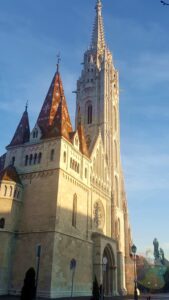
Matthias Church
Fisherman’s Bastion and a contemporary hotel are the other occupants of this complex and present great views of the city from each side, most important and fascinating being the Hungarian Parliament across the river over the Pest side of the city.

Guess who is standing at the Fisherman’s Bastion

Sun setting over the Skyline of Budapest as seen from Castle Hill

Evening view of Parliament and Széchenyi bridge from Castle Hill

Entrance to Budapest Terasz Cafe
The south side of the castle hill stands over the famous Gellert Hill offering more panoramic views of the city from the Citadel. The famous Gellert Hotel with its world famous Gellert Thermal Spa is also attached to the hill and takes the natural thermal spring water from within the hill.
In one of my trips, our conference ended earlier than expected and I walked towards the Parliament building to see how it looked during the day time. On my way I stumbled on the famous Ethnographic museum called the Néprajzi Múzeum. My baby brother had once told me about it as one of his friends visited it and raved about it so I promised my brother that I will take a few pictures for him when I went there. The time was not enough to enable me to visit it from inside so I took some pictures from the outside. The museum exhibits Hungarian Folk objects from 19th century and some of the items from Pre-World War times of Hungary. Too bad, I did not get to see them but one day when I visit Eastern Europe with my brother, I am going to see everything and experience it with him as he is much more knowledgeable in the political aspect of Europe, than I am. I have promised him a World War tour of Europe to explore the history with pre and post-world war perspective. That could make a great package for World War enthusiasts. Hmmm… Great Idea!! Let me work on that. 😊

Néprajzi Múzeum
Opposite to the Museum, stands the grand building of Hungarian Parliament whose architecture is influenced by British Houses of Parliament in London.


Hungarian Parliament
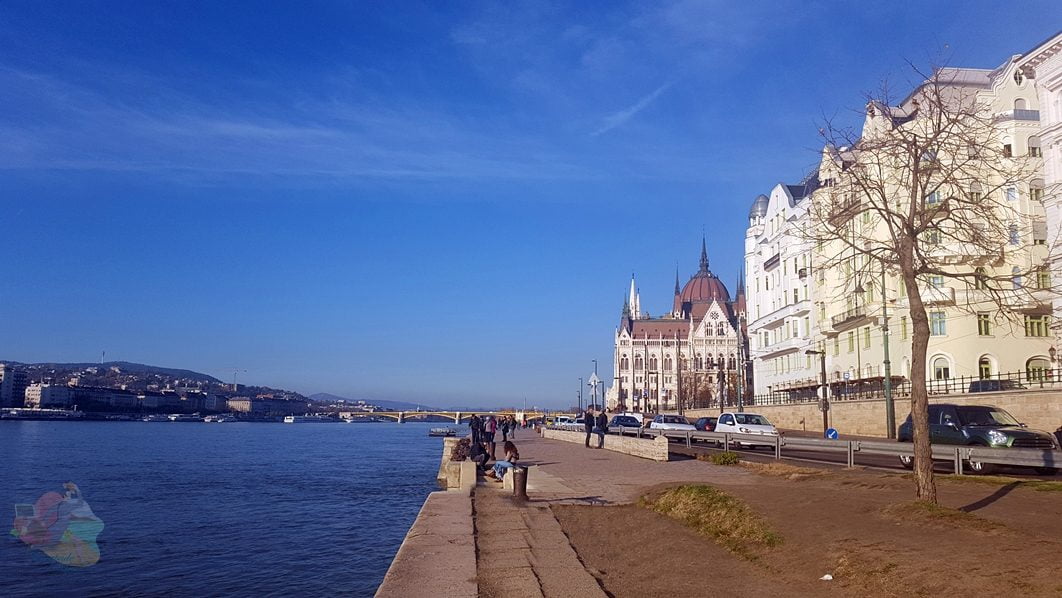
Riverbank view of the Parliament of Hungary
One of the many interesting and enjoyable afternoon activities is to take the Budapest River Cruise which cruises through the Danube River and passes beneath important bridges, passing along the skyline of Budapest up to the Margaret Island which in itself is a place worth visiting if the time allows. These cruises usually pack a deal of a good dinner and traditional Hungarian Folk music played live on board, as well as the opportunity to take in the beauty of the monuments along the river viewed from the open-air deck.

Traditional Hungarian Folk Music in a Riverboat Cruise

Dining in the Cruise

View of Parliament from the Cruise

Multicultural food scene of the city is the next best thing on the list of great experiences offered to tourists. Hungarian culture has openly embraced the influence and amalgamation of foreign cuisines. Budapest has many of the international food franchises open in the city which were resisted by their European counterparts for years. From local Hungarian food to Italian, French, Chinese and Korean cuisines, the city has it all. For a person like me looking for Halal food being a Muslim, the city is packed with so many Halal restaurants and joints that there is so much variety to choose from. There are several Lebanese, Turkish and Syrian restaurants offering great fresh Halal food at a very reasonable price. Most places accept both Hungarian Forints and Euros and cash is almost never needed.
My favourite ones are MiR Resturaunt near Deák Ferenc metro station which is the centre point for going to all important places and activities. The other one that I really liked and used to go almost daily in the evening was Al-Amir. Best platters with fresh barbecued meat served with rice/bread followed by traditional Arabic Mint Qahwa, were an absolute delight.
The city also has food stalls during Christmas markets and other important festive times. The street stalls sell fish, Goulash soups and many other meat varieties.

Street Stalls of the Christmas Markets
Murals/ Street Art of Budapest
The modern side or the party side of the city is the Pest side and presents a famous street called Király Street could be a big part of one’s trip if one is interested in street art. I happened to join one of the free walking tours of the city and got to explore the modern side of Budapest along the Király street in Pest. Some of the amazing murals that I captured on my camera are as follows:
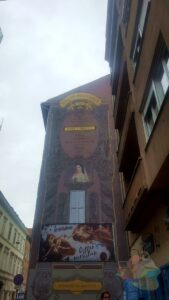
Historical figure of Empress Elizabeth of Bavaria commonly known as Sissy
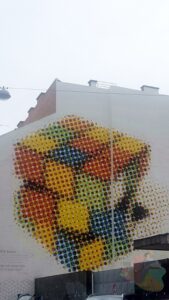
A tribute to Ernő Rubik’s Cube as a 3D Mural at Dob street 10, Erzsébetváros (7th District of Budapest) by Neo Paint Group
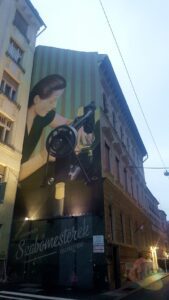
A mural dedicated to a Budapest seamstress as tailoring was once one of the most famous and prevalent professions specially in the Kiraly area.

A satirical mural depicting the rivalry between the people of Buda and Pest where Buda people consider Pest-ians to be lazy
The heart of Pest also has the famous shopping area of Budapest called Belváros consisting of very walkable shopping streets and the most famous street Váci utca of the inner city.

A street in Pest, decorated for the festive season
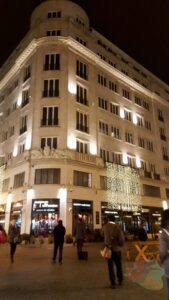
Bomo Art Budapest
One of the very interesting stops in Budapest is the visit to a stationary shop called Bomo Art in Budapest. A colleague of mine introduced me to the shop as he was a fan of leather jacketed journals and diaries. He made it a point to visit Bomo Art shop each time we were in Budapest. Since stationary shops are my Disneyland too, I thoroughly enjoyed the visit to Bomo Art each time I was in Budapest.
The shop is in Régi posta Street and carries a range of exclusive products made of cow leather and water marked paper which makes it unique and special. The stationary that it carries includes wrapping papers, post cards, photo albums, pens, maps and much more. The stationary not only beautifully portrays touristic sights and most beautiful buildings from Budapest, but also the old posters feature motives and musical notes from famous Hungarian Artists and highlight the turn of the century.
I personally love buying small greeting cards from there, which have the prettiest paintings, motives and flowers which give a very classy look to any gift they are attached to. I usually write greetings with a pen with a cut nib in fountain ink and include it in any gifts that I give on special occasions. For any leather enthusiast or stationary fan like me, Bomo Art is a wonderful place to make a stop at and even for buying authentic Hungarian Souvenirs.

Greeting Cards from bomo Art

( Credit: Bomo Art website https://www.bomoart.com/greeting-card)
Disclaimer: No part of this blog is a promotion to any place, activity or restaurant. It is solely my own opinion and based on my experience and does not involve any collaboration.
Thermal Baths of Budapest
Budapest sits on some 129 natural thermal springs with amazing therapeutic waters with actual medicinal properties, unlike some commercial spas (outside Europe) feigning plain hot water as therapeutic waters and charging an arm and a leg for the fake waters. Although there are many famous Thermal baths and spas in Budapest, the three baths Széchenyi Bath; the biggest of the baths and most famous, Gellért bath attached to the Gellért hotel and Rudas Bath are the most popular ones
My favourite evening activity used to be heading towards Rudas thermal bath after work. Standing at the foot of the Gellert Hill, this Turkish era Hammam is the only “women only” thermal bath in Budapest which is “Women Only” on Tuesdays, thus making it a much more relaxed atmosphere and private experience for me. For 4 hours pass with access to steam rooms and pools, showers and a locker, there was a nominal fee of 8 Euros (2017/2018 price) which I would have happily paid daily, if I lived in Budapest. Pools ranging from 18 degrees Celsius to a high temperature of 42 degrees Celsius gave a complete rejuvenating experience to the body’s circulation system. Steam rooms up to a temperature of 50 Degrees celsius were an absolute must for all the locals that frequent the thermal bath and socialize and chat like they were in a café or a pub. Going to baths is quite a routine and not something of a social status such as in North America. Natural remedies and sources of nutrition are part of European culture and that is the reason, holistic approach is the way of their life. Unless absolutely allergic to some foods, most people do not fuss over being dairy free or this free and that free. Most people eat everything and are ten times healthier than all those claiming how meat, carbs and dairy are killing humanity. The food is hormone and preservative free, is freshly sourced and is healthy to be eaten by everyone. As simple as that.
Different types of massages and treatments are also available at request and prior booking, price range of which depends on the time and the type of Thermal Spa chosen. The fancy spas will obviously charge more. I however paid a total of 50 euros for a 60 mins massage and the spa pass for 5 hours. Great value for money compared to the horrendous prices we pay in North America and that too for a non-authentic experience.
I remember a funny story of myself in the steam room. I probably lost track of time and got so red in the face that a lady sitting next to me tried to warn me in Hungarian which I did not understand but I got that much that something was wrong with me. Not having the time for explaining it to me in her extremely limited English, she dragged me to the common shower where she filled a wooden pale with ice cold water and threw over my head to bring my temperature down and slow down my blood circulation. She then told me I would have had serious damage if I would not have been splashed with cold water. It gave me a brain freeze for a moment but afterwards I felt wonderful and the ladies in the common area explained to me how necessary it is to use both cold and hot water even while showering at home.
Another fun story is related to the therapeutic aqueduct water at Rudas Bath that has sulfur rich water which smells like very pungent garlic water. In fact, all thermal spas have this available as they all source from natural springs and fountains of Budapest. The local elderly ladies were very concerned about my real experience of the medicinal waters and so pushed me to drink the smelly water from the fountain. They explained to me how it was so good for the liver and spleen and detoxifies the body from toxin build up. I reluctantly drank it and did not like the taste but the next day, I got the secret of nobody being fat in Hungary despite the food being quite fatty. Total detoxification…. 😉
One can bring this smelly but healthy water filled in one’s bottle at a nominal charge, although I never had to pay anything when I used to go. Ahh…. Nice memories. I felt like a person reborn, after each spa day.
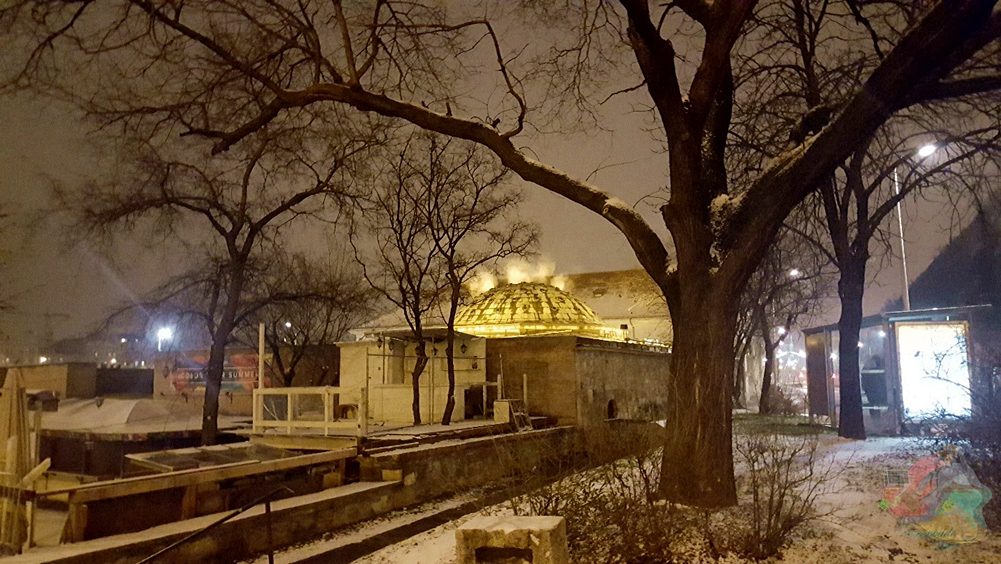
Rudas bath; a Turkish Hammam built on Natural Thermal Springs in the Ottoman Era in 1550
Unfortunately, even holidays end and these were not even holiday trips to Budapest so I used to board the early morning flight to Milan and head straight to office for another consuming day at work. In the picture below my plane has just taken off from Budapest Ferenc Liszt International Airport and is soaring above Danube river.
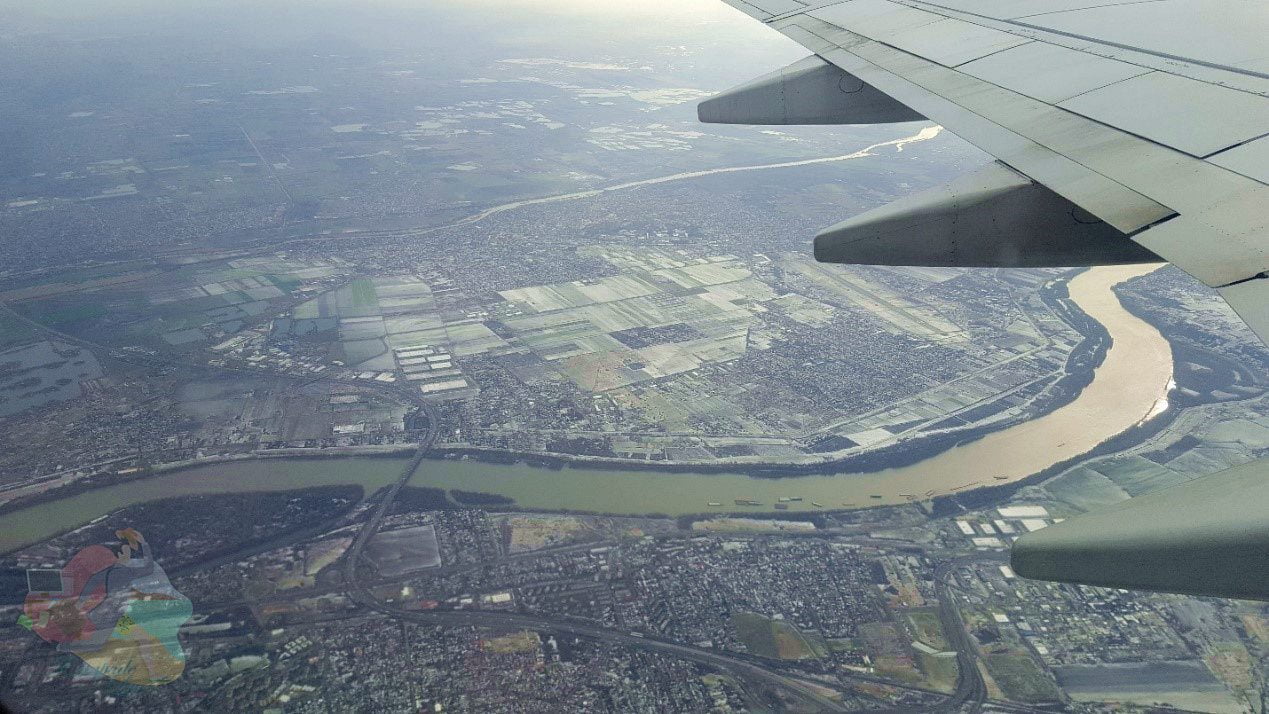
View of mighty Danube river from the aeroplane after take off
